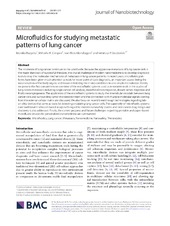| dc.contributor.author | Ruzycka, Monika | en_US |
| dc.contributor.author | Cimpan, Mihaela Roxana | en_US |
| dc.contributor.author | Rios Mondragon, Ivan | en_US |
| dc.contributor.author | Grudzinski, Ireneusz | en_US |
| dc.date.accessioned | 2020-06-17T11:57:35Z | |
| dc.date.available | 2020-06-17T11:57:35Z | |
| dc.date.issued | 2019-05-27 | |
| dc.Published | Ruzycka, Cimpan MR, Rios Mondragon I, Grudzinski. Microfluidics for studying metastatic patterns of lung cancer. Journal of Nanobiotechnology. 2019;17:71 | eng |
| dc.identifier.issn | 1477-3155 | |
| dc.identifier.uri | https://hdl.handle.net/1956/22680 | |
| dc.description.abstract | The incidence of lung cancer continues to rise worldwide. Because the aggressive metastasis of lung cancer cells is the major drawback of successful therapies, the crucial challenge of modern nanomedicine is to develop diagnostic tools to map the molecular mechanisms of metastasis in lung cancer patients. In recent years, microfluidic platforms have been given much attention as tools for novel point-of-care diagnostic, an important aspect being the reconstruction of the body organs and tissues mimicking the in vivo conditions in one simple microdevice. Herein, we present the first comprehensive overview of the microfluidic systems used as innovative tools in the studies of lung cancer metastasis including single cancer cell analysis, endothelial transmigration, distant niches migration and finally neoangiogenesis. The application of the microfluidic systems to study the intercellular crosstalk between lung cancer cells and surrounding tumor microenvironment and the connection with multiple molecular signals coming from the external cellular matrix are discussed. We also focus on recent breakthrough technologies regarding lab-on-chip devices that serve as tools for detecting circulating lung cancer cells. The superiority of microfluidic systems over traditional in vitro cell-based assays with regard to modern nanosafety studies and new cancer drug design and discovery is also addressed. Finally, the current progress and future challenges regarding printable and paper-based microfluidic devices for personalized nanomedicine are summarized. | en_US |
| dc.language.iso | eng | eng |
| dc.publisher | BMC | eng |
| dc.rights | Attribution CC BY | eng |
| dc.rights.uri | http://creativecommons.org/licenses/by/4.0/ | eng |
| dc.subject | Lungekreft / Lung cancer | eng |
| dc.subject | Mikrofluidikk / Microfluidics | eng |
| dc.subject | Nanomaterialer / Nano materials | eng |
| dc.title | Microfluidics for studying metastatic patterns of lung cancer | en_US |
| dc.type | Peer reviewed | |
| dc.type | Journal article | |
| dc.date.updated | 2020-01-31T12:17:18Z | |
| dc.description.version | publishedVersion | en_US |
| dc.rights.holder | Copyright 2019 The Author(s) | |
| dc.identifier.doi | https://doi.org/10.1186/s12951-019-0492-0 | |
| dc.identifier.cristin | 1701974 | |
| dc.source.journal | Journal of Nanobiotechnology | |
| dc.relation.project | Norges forskningsråd: 246672 | |
| dc.subject.nsi | VDP::Medisinske fag: 700::Basale medisinske, odontologiske og veterinærmedisinske fag: 710 | |
| dc.subject.nsi | VDP::Midical sciences: 700::Basic medical, dental and veterinary sciences: 710 | |

